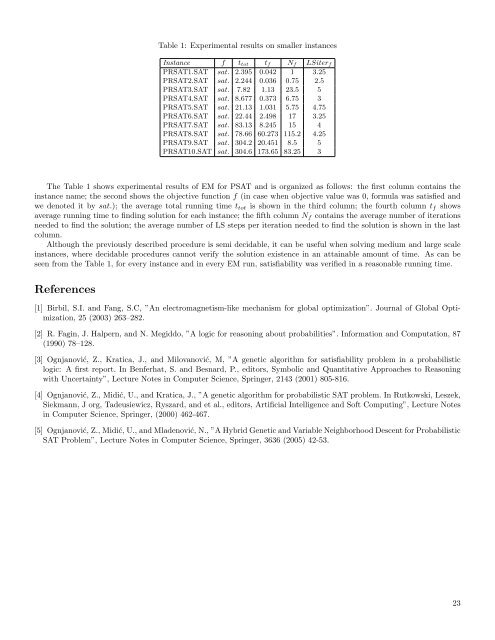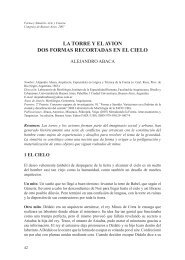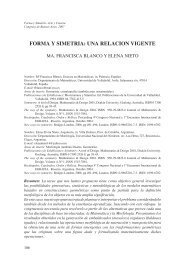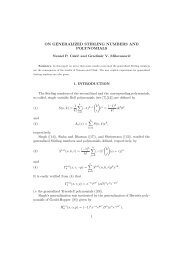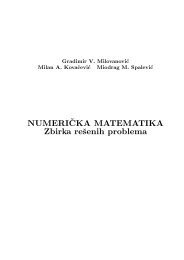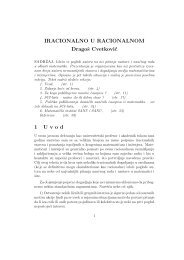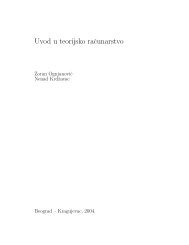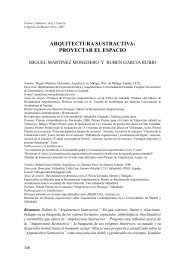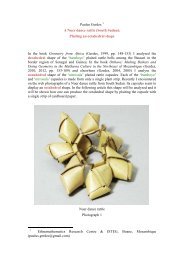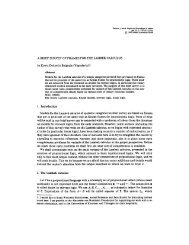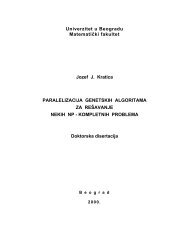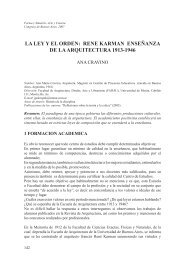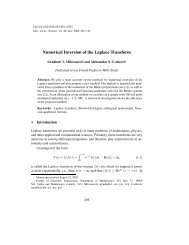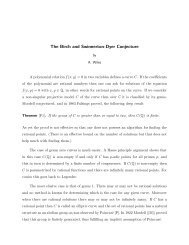Electromagnetism metaheuristic for probabilistic satisfiabilityproblemJasmina FijuljaninFaculty <strong>of</strong> Ma<strong>the</strong>maticsUniversity <strong>of</strong> Belgradefjasmina@yahoo.comAleksandar KarteljFaculty <strong>of</strong> Ma<strong>the</strong>maticsUniversity <strong>of</strong> Belgradekartelj@matf.bg.ac.rsJelena KojićFaculty <strong>of</strong> Ma<strong>the</strong>maticsUniversity <strong>of</strong> Belgradejagodita@gmail.comProbabilistic logics are used to reason about uncertainty expressed in terms <strong>of</strong> probability. In <strong>the</strong>se logics classicalpropositional language is expanded by expressions that speak about probability, while formulas remain true or false.The problem <strong>of</strong> verifying satisfiability <strong>of</strong> a probabilistic formula (PSAT, also called <strong>the</strong> decision form <strong>of</strong> probabilisticsatisfiability) is NP-complete [2]. PSAT can be reduced to a linear programming problem. The number <strong>of</strong> variables in<strong>the</strong> linear system corresponding to <strong>the</strong> formula is exponential in <strong>the</strong> number <strong>of</strong> propositional letters from <strong>the</strong> formula. Inpractice, any standard linear system solving procedure is not suitable when scaling up to larger formulas. Few approacheswere previously proposed for solving this problem: genetic algorithms [3, 4, 5] and variable neighborhood search [5].The motivation behind <strong>the</strong> use <strong>of</strong> <strong>the</strong> electromagnetism metaheuristic (EM) originates from <strong>the</strong> resemblance between<strong>the</strong> electromagnetism <strong>the</strong>ory <strong>of</strong> physics, and basic idea is to take <strong>the</strong> algorithm’s search close to <strong>the</strong> regions with betterobjective functions. The EM is used for global and combinatorial optimization and categorized as a stochastic populationbasedalgorithm. It is centered on analogy with <strong>the</strong> attraction-repulsion mechanism <strong>of</strong> <strong>the</strong> electromagnetism <strong>the</strong>ory tomove <strong>the</strong> sample solutions to converge to optimality based on <strong>the</strong>ir associated charges.The input <strong>of</strong> <strong>the</strong> program, which uses EM for solving PSAT problem, is a formula φ in a weight conjunctive form(wcf), with L weight literals <strong>of</strong> <strong>the</strong> form t i ρ c i . Without loss <strong>of</strong> generality, we demand that classical formulas appearingin weight terms are in disjunctive normal form. Let ϕ(f) = p 1 , ..., p N denote <strong>the</strong> set <strong>of</strong> all primitive propositions from wcfformula. Our goal is to find a probabilistic model M such that M |= φ.Each solution point from <strong>the</strong> solution space is represented by a vector from [0, 1] L·(N+1) , which describes a probabilisticmodel. The first L · N coordinates represent primitive propositions that are rounded to {0, 1} by using some thresholdvalue (in our implementation it is set to 0.5). Rounded value 0 at <strong>the</strong> position i denotes negative literal ¬p i , while 1denotes positive literal p i . Last L coordinates correspond to probabilities assigned to each atom, and <strong>the</strong>ir values arenormalized in such a way that <strong>the</strong>ir sum is equal to 1.We define an objective function f as a degree <strong>of</strong> unsatisfiability <strong>of</strong> EM points, denoted by s k , k ∈ {1, ..., m}. Thedegree is defined as a distance between left side values <strong>of</strong> <strong>the</strong> weight literals <strong>of</strong> <strong>the</strong> form a i 1w(α1) i + ... + a i n iw(αn i i) ρ i c ithat are not satisfied in <strong>the</strong> model described by an EM point s k , and <strong>the</strong> corresponding right side values.We used local search (LS) to improve <strong>the</strong> solution in each step, as in [3, 4]. The best and worst formula, according to<strong>the</strong> objective function, are determined, and <strong>the</strong>ir atom probabilities are being exchanged in order to improve it.In <strong>the</strong> initialization part, EM points are created and each coordinate from a solution point is randomly selected from[0,1]. In each ( iteration, EM points are being)evaluated by calculating <strong>the</strong>ir charges, given by <strong>the</strong> following formula:f(sq i = exp −|L · (N + 1)|i)−f(s best ), where s best is <strong>the</strong> best EM point so far. Power <strong>of</strong> connection between two∑ mj=1 (f(sj)−f(s best))points will be proportional to <strong>the</strong> product <strong>of</strong> charges and reciprocal to <strong>the</strong> distance between <strong>the</strong>m. Finally, total forcethat <strong>the</strong>se charges produce is applied. The resulting force F i on <strong>the</strong> ⎧ point ( i is <strong>the</strong> ) sum <strong>of</strong> force vectors induced by all o<strong>the</strong>r∑neighbor points on <strong>the</strong> point i: F i =m ⎨ qiq j||sF ij , where F ij =j−s i||· (s 2 j − s i ), f(s j ) < f(s i )( )j=1,j≠i⎩ qiq j. Calculated||s j−s i||· (s 2 i − s j ), f(s j )f(s i )value <strong>of</strong> F i is normalized, so it represents a direction in which a point is going to move. New location <strong>of</strong> <strong>the</strong> EM point iscalculated as in [1], and it will depend on its objective value and current location so EM point will stay in <strong>the</strong> solutionspace. The points with a higher charge will move o<strong>the</strong>r points in <strong>the</strong>ir direction more strongly. Note that <strong>the</strong> best EMpoint will not be moved.EM based algorithm for PSAT is implemented in C programming language, compiled in Visual Studio 2010, andtested on PRSATX.SAT instances described in [3], which used set <strong>of</strong> formulas that are known to be satisfiable. For eachinstance EM was executed with four different seed values <strong>of</strong> a random number generator. For instances PRSAT1.SAT- PRSAT8.SAT <strong>the</strong> size <strong>of</strong> population, m, is set to 10, and for instances PRSAT9.SAT and PRSAT10.SAT, m is 12.Maximal number <strong>of</strong> iterations is 150, and maximal number <strong>of</strong> LS steps in each iteration is set to 5. All computationalresults were carried out on Intel 2GHz single processor with 3GB memory.22
Table 1: Experimental results on smaller instancesInstance f t tot t f N f LSiter fPRSAT1.SAT sat. 2.395 0.042 1 3.25PRSAT2.SAT sat. 2.244 0.036 0.75 2.5PRSAT3.SAT sat. 7.82 1.13 23.5 5PRSAT4.SAT sat. 8.677 0.373 6.75 3PRSAT5.SAT sat. 21.13 1.031 5.75 4.75PRSAT6.SAT sat. 22.44 2.498 17 3.25PRSAT7.SAT sat. 83.13 8.245 15 4PRSAT8.SAT sat. 78.66 60.273 115.2 4.25PRSAT9.SAT sat. 304.2 20.451 8.5 5PRSAT10.SAT sat. 304.6 173.65 83.25 3The Table 1 shows experimental results <strong>of</strong> EM for PSAT and is organized as follows: <strong>the</strong> first column contains <strong>the</strong>instance name; <strong>the</strong> second shows <strong>the</strong> objective function f (in case when objective value was 0, formula was satisfied andwe denoted it by sat.); <strong>the</strong> average total running time t tot is shown in <strong>the</strong> third column; <strong>the</strong> fourth column t f showsaverage running time to finding solution for each instance; <strong>the</strong> fifth column N f contains <strong>the</strong> average number <strong>of</strong> iterationsneeded to find <strong>the</strong> solution; <strong>the</strong> average number <strong>of</strong> LS steps per iteration needed to find <strong>the</strong> solution is shown in <strong>the</strong> lastcolumn.Although <strong>the</strong> previously described procedure is semi decidable, it can be useful when solving medium and large scaleinstances, where decidable procedures cannot verify <strong>the</strong> solution existence in an attainable amount <strong>of</strong> time. As can beseen from <strong>the</strong> Table 1, for every instance and in every EM run, satisfiability was verified in a reasonable running time.References[1] Birbil, S.I. and Fang, S.C, ”An electromagnetism-like mechanism for global optimization”. Journal <strong>of</strong> Global Optimization,25 (2003) 263–282.[2] R. Fagin, J. Halpern, and N. Megiddo, ”A logic for reasoning about probabilities”. Information and Computation, 87(1990) 78–128.[3] Ognjanović, Z., Kratica, J., and Milovanović, M, ”A genetic algorithm for satisfiability problem in a probabilisticlogic: A first report. In Benferhat, S. and Besnard, P., editors, Symbolic and Quantitative Approaches to Reasoningwith Uncertainty”, Lecture Notes in Computer Science, Springer, 2143 (2001) 805-816.[4] Ognjanović, Z., Midić, U., and Kratica, J., ”A genetic algorithm for probabilistic SAT problem. In Rutkowski, Leszek,Siekmann, J org, Tadeusiewicz, Ryszard, and et al., editors, Artificial Intelligence and S<strong>of</strong>t Computing”, Lecture Notesin Computer Science, Springer, (2000) 462-467.[5] Ognjanović, Z., Midić, U., and Mladenović, N., ”A Hybrid Genetic and Variable Neighborhood Descent for ProbabilisticSAT Problem”, Lecture Notes in Computer Science, Springer, 3636 (2005) 42-53.23


